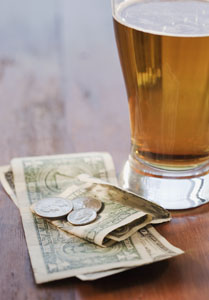
Jamie Grill/Getty
Adding to previous research suggesting that incremental increases in the cost of alcohol can yield significant health and financial benefits, a new study published online this week in the journal The Lancet suggests that slightly increasing the per unit cost of alcohol could prompt people to drink less, resulting in fewer cases of alcohol-related disease and death and reducing health care costs. In the U.K. in 2006-2007 some 800,000 people were admitted to the hospital for alcohol-related illness or injury, costing the National Health Service some $4.2 billion. (In the U.S., 4 million people visit the emergency room for alcohol-related illness or injury each year, and 1.6 million are hospitalized, according to 2005 data from the Centers for Disease Control.) In the U.S. nearly 80,000 deaths are attributed to excessive alcohol consumption each year, and in the U.K., the annual number of alcohol-related deaths has been steadily increasing in the past two decades, to 13.6 deaths per 100,000 people as of 2008. It’s no surprise then that public health officials are attempting to devise strategies to decrease at-risk drinking, and the health consequences ranging from liver disease to drunk-driving crashes that can accompany it.
In this latest analysis, researchers from the University of Sheffield used epidemiological and mathematical models to determine that a cost increase of just 75¢ (£.50) per unit of alcohol could have dramatic health—and financial—benefits. After 10 years, the additional 75¢ cost could result in 2,900 fewer premature deaths annually, 41,000 fewer cases of chronic disease, and 8,000 fewer alcohol-related injuries. What’s more, that small increase could also mean 92,000 fewer alcohol-related hospital admissions, saving the NHS some $406 million (£270 million) each year. For all of those benefits, the average drinker would face an additional tab of about $56, the study authors conclude.
A slightly smaller additional fee—60¢ (£.40) per unit of alcohol—would also yield significant benefits, the researchers say. For a cost of about $33 more per drinker each year, after 10 years of implementation the extra cost could result in 1,200 fewer premature deaths, 17,000 fewer cases of chronic illness and 38,000 fewer hospital annual alcohol-related hospital admissions, meaning a health care savings of $165 million (£110 million) per year.
Tacking on an additional cost for booze would be most beneficial to the highest risk groups, the authors argue. “We predicted that harmful drinker subgroups would have the largest health gains and spending burden from pricing policies,” they write, and that these price increases would most effectively target at-risk drinkers between the ages of 18-24.

